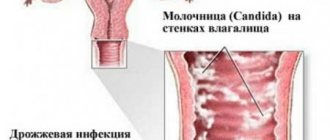One of the dangerous clinical manifestations of urinary system pathology is cystitis with blood. As a rule, this phenomenon indicates vascular damage.
According to medical statistics, such disorders are more common in women. A strong half of humanity suffers from this disease much less often and the secret lies in the anatomical features of the urethra.
The size of the male channel is several times larger than the female one, which reduces the entry of infection into the body several times.
As a rule, men develop cystitis if the infection enters through other inflamed organs or if there is a chronic pathology of the urethra.
When the first symptoms appear, you should contact a qualified specialist. Timely diagnosis, and, consequently, treatment will help avoid serious complications.
Reasons for the development of the disease
The following reasons are identified that subsequently lead to the formation of cystitis with blood in women:
- Regular artificial retention of urination. In this case, excessive stretching of the muscle fibers occurs, as a result, blood circulation is disrupted and blood enters the urine.
- The presence of a foreign body in the genitourinary tract that affects the mucosal epithelium, thereby damaging it.
- Neurogenic conditions in which the walls contract insufficiently.
- In women: during pregnancy or menopause.
- In men, as a symptom or consequence of adenoma.
- Incorrect or irregular intimate hygiene, causing inflammation and hemorrhagic cystitis.
- The formation of malignant or benign neoplasms in the organs of the urinary system.
- General decrease in immunity.
- Venereal diseases.
In addition, cystitis with blood appears as a side effect when using cytostatics.
If one or more factors are present, it is necessary to undergo regular preventive examinations and adhere to therapy in order to reduce the risk of urinating with blood.
Possible complications
One of the common complications is bladder tamponade, that is, its blockage. A blood clot closes the lumen of the bladder, as a result, urine cannot escape and significant stretching of the organ occurs.
In addition, blood poisoning can occur, as pathogenic bacteria penetrate into the bloodstream through injured vessels. If left untreated, inflammation of the kidney tissue or pyelonephritis develops.
The main complication is blockage of the urethra due to thickened blood in the urine due to cystitis. In this case, the flow of blood into the urethra does not stop, and the bladder begins to gradually stretch. If cystitis with blood is not treated, the pathology can lead to the following complications:
- Abscess development;
- The appearance of a tumor;
- Nervousness;
- Sleep disturbance;
- Spread of the inflammatory process to the reproductive organs;
- Development of iron deficiency anemia due to prolonged blood loss.
Also, cystitis with blood, which is not treated, can cause blood poisoning, pyelonephritis, as well as acute inflammatory and purulent processes in the pelvic organs. And with independent uncontrolled treatment of pathology, it is possible for the body to develop addiction to the drugs used from the antibacterial group.
Clinical picture
The manifestations of this disease are similar to the clinical picture of simple cystitis:
- A person experiences an almost constant urge to urinate. In this regard, the patient cannot fully restore strength, general fatigue and malaise appear.
- Often, urine does not pass, causing pain in the lower abdomen. In addition, acute pain occurs at the end of urination. A person suffers from regular spasms.
- If the disease becomes protracted, the person develops iron deficiency. As a result, the patient begins to suffer from dizziness and shortness of breath.
- The disease is also characterized by sudden changes in body temperature and fever.
If women experience the above symptoms of cystitis with blood, it is necessary to contact a specialist as soon as possible.
Why does blood appear in urine?
The lining of the bladder begins to bleed when it becomes eroded and the blood vessels are exposed. In another case, the mucous membrane remains intact, but the walls of the vessels penetrating it become “loose”, and penetrating through them, red blood cells color the urine pink or brown.
Various factors lead to dysfunction of the bladder, which can be divided into two groups: those not associated with infections and those caused by pathogens.
Non-infectious causes
Non-infectious cystitis with blood is most often caused by mechanical damage to the bladder and/or ducts and their blockage. It often occurs in people who are accustomed to enduring the urge to urinate for a long time: when the muscle fibers of the bladder are overstretched, blood circulation in its walls is disrupted, and inflammation begins. The same thing happens in people for neurogenic reasons, when the contractility of the muscles of the bladder is weakened, and it “forgot how” to give the signal to urinate on time.
Hemorrhagic cystitis can provoke a mechanical obstruction to the outflow of urine. It happens:
- due to congenital narrowing of the urethra or its spasms;
- when its lumen is blocked by an internal tumor or a tumor of neighboring organs presses on the urethra - the bladder, prostate adenoma in men, cancer of the uterus and ovaries in women, etc.;
- if a “pebble” gets stuck in the urethra, completely or partially blocking it and scratching the mucous membrane with sharp edges.
Cystitis of non-infectious origin sometimes develops after chemical poisoning. In people with a sensitive bladder, it can be triggered by spicy foods and seasonings or excessive drinking of alcohol.
Medicines, for example those used in the treatment of cancer, can also provoke cystitis and bleeding of the bladder walls. Thus, the antitumor drug Cyclophosphamide, after processing in the body, forms caustic compounds that are excreted in the urine and irritate the bladder mucosa. Irradiation of the suprapubic region, carried out for tumors of the genitourinary tract, also leads to bleeding of the mucous membranes.
Impact of infections
The second group of reasons why hemorrhagic cystitis occurs is infection. It can be caused by any pathogen: fungi, viruses, bacteria, especially if hygiene rules are neglected:
- In women and girls, cystitis with blood begins against the background of a bacterial infection: microbes from the rectum and vagina easily penetrate into the short and wide urinary canal. Pregnant women, mothers in the postpartum period, and pre- and postmenopausal women often fall ill due to a decrease in their general and local immunity.
- In men and boys, hemorrhagic cystitis is provoked by adenoviruses, and less commonly by cytomegalovirus and herpes virus. Due to a violation of local immunity and microcirculation of blood in the bladder caused by viruses, secondary bacterial infection occurs.
Regardless of age and gender, bladder bleeding can be a complication of chlamydia or gonorrhea. Occasionally it is caused by fungi and protozoan microorganisms (mycoplasma, ureaplasma).
Necessary research
If signs of cystitis with blood appear, you should consult a therapist, who can prescribe a series of medical tests, and then redirect you to a urologist or gynecologist.
The necessary tests that you must undergo include: blood and urine tests, cystoscopy, x-rays, bacteriological urine culture.
Blood analysis
When making this diagnosis, a blood test is carried out in order to determine the level of the inflammatory process in the body. Based on the results obtained, the specialist prescribes treatment.
The diagnosis is repeated after undergoing therapy in order to exclude the development of complications.
Analysis of urine
A diagnostic method is required that allows you to confirm the content of erythrocytes and leukocytes in urine. This method also determines the presence of fungi and bacteria. Based on the results of a urine test, a specialist can confirm or deny urolithiasis.
Bacteriological culture of urine
This type of diagnosis is used to determine the causative agent of the disease that led to cystitis. In addition, this test allows you to find out the presence of fungi and bacteria in urine.
This study examines the species of pathogens and their response to antibiotics. Conducting bacteriological cultures takes approximately a week. Based on the results of this analysis, the specialist can prescribe highly targeted antibiotics.
Cystoscopy
One of the painful diagnostic methods is used in cases of prolonged illness or in the presence of a foreign body in the bladder.
The procedure is a visual examination of the organs of the urinary system using a special optical instrument - a cystoscope.
If an inflammatory process is detected in the body, this diagnostic test is excluded.
X-ray of the bladder and kidneys
An additional diagnostic method allows you to identify stones, neoplasms, pathological narrowing, and artificial passages between organs. In addition, it makes it possible to determine pathological anomalies and the condition of organ walls.
Other studies
In addition, there are rapid tests that help confirm the diagnosis. A test with an indicator strip for the presence of nitrates in urine, which appear when exposed to pathogens. Express tests to detect protein, leukocytes and red blood cells in urine.
How to distinguish it from other diseases?
If bloody content appears in urine, it is recommended to urgently seek help from a doctor for a qualified differential diagnosis and prescribing appropriate treatment.
Similar bleeding can occur with other equally serious diseases:
- Glomerulonephritis.
- Mechanical damage inside the bladder.
- Diseases of an oncological nature, the formation of malignant tumors.
- Bleeding inside due to thinning of the capillary walls, as well as changes in hemocoagulation.
- Urolithiasis.
When the disease begins, blood in the urine of women with cystitis is detected at the very end when emptying the bladder. But as the disease develops, lymph is observed both in the primary urine and in the middle. The same is true for cystitis in men.
Fixation of bloody discharge at the very beginning of urination indicates the beginning of urethritis.
Methods of treating pathology
It is necessary to begin therapy for this disease only after a personal consultation with a doctor and all diagnostic tests. If treatment is incorrect or prolonged, the disease can become chronic.
Antibiotics
In the case of a bacterial infection, cystitis with blood is treated with the help of highly targeted antibiotics that can destroy pathogenic microorganisms.
In addition, these drugs effectively relieve the inflammatory process.
Most often, in the fight against this disease they use:
- Monural;
- Nolitsin;
- Palin;
- Furagin;
- Rulid.
Antibiotics are prescribed only by the attending physician based on bacteriological urine culture.
Antiviral and immunomodulatory drugs
Such drugs are prescribed for viral onset of the disease and as a prophylaxis for chronic cystitis. Among the immunomodulatory drugs are:
- Cycloferon;
- Imunorix;
- Viferon.
The regimen for taking antiviral drugs is developed depending on the disease.
Drugs that stop bleeding and strengthen the walls of blood vessels
At later stages of the disease, in order to prevent the development of bladder tamponade, agents are prescribed that stop the blood and strengthen the walls of blood vessels. Among these drugs are:
- Etamsylate;
- Viprosal;
- Chemoroidin;
- Pylex.
Analgesics and antispasmodics
This group of drugs is aimed at relieving pain and spasms. In the case of this disease, Drotaverine or No-shpa is usually prescribed, since these drugs have an excellent effect on smooth muscles.
Diet
When undergoing a therapeutic course, the patient must also follow a gentle diet, which includes:
- exclusion of fried, fatty, salty and spicy foods;
- increasing consumption of fresh vegetables, soups, lean meats and dairy products.
The patient’s entire diet should be easily digestible and not cause discomfort or heaviness in the stomach.
Other treatments
If cystitis becomes chronic, the doctor may additionally prescribe various physiotherapeutic procedures, which are most often aimed at enhancing the effect of the main treatment and maintaining the body.
In addition, many modern specialists add traditional medicine recipes to the treatment of cystitis.
Please note that self-treatment with such methods can harm the body.
Can blood bleed with cystitis?
Many women suffer from a disease such as cystitis. This is a disease of the bladder and it can take different forms. Most often, in women, it manifests itself as hemorrhagic cystitis with blood in the urine. This is a chronic disease that constantly torments females.
People with cystitis generally have a very low level of hemoglobin and a small number of red blood cells in the blood. Some people experience a huge oxygen deficiency. Since acute cystitis is a very serious problem, its treatment must be approached with the utmost seriousness.
Many people ask: “Is there blood with cystitis?”
In fact, cystitis is not always accompanied by blood when urinating. Sometimes, bloody discharge may appear due to internal hemorrhage. Because of this, the physical condition of women can deteriorate sharply, cold sweats appear and the heartbeat increases. In such cases, you need to call a doctor or take the patient to the hospital.
Many doctors explain why blood occurs with cystitis. This is due to the fact that when an infection enters the bladder, the mucous membrane is damaged, which eventually begins to bleed.
According to statistics, blood clots in cystitis appear only when the disease becomes chronic or serious complications arise during the inflammatory process. This fact indicates that exacerbations of hemorrhagic cystitis can be prevented.
Therefore, in order to understand whether cystitis can cause bleeding, you need to consult a doctor.
Most often, cystitis streaked with blood appears in women aged 22-43 years . This symptom is very difficult to get rid of, which is why many women suffer from bleeding throughout their lives.
Some women do not understand why they have blood clots in their urine when they are not menstruating.
Cystitis with blood in women or hemorrhagic inflammation of the bladder can occur due to various factors, for example:
- Poor personal hygiene,
- Weak immunity,
- Pathologies of the bladder,
- Urolithiasis disease,
- Serious gynecological diseases,
- Tumor in the urinary tract,
- Chronic disease of the thyroid gland.
These are just some of the causes of cystitis in women with blood, there are many more, but they all perform one function - they violate the protective layer of the mucous membrane of the bladder.
Because of this, any infection that gets on the walls of a vulnerable organ contributes to and develops the inflammatory process. Escherichia coli is the most common cause of cystitis in women, causing blood in the urine. But there are still some causative agents of the inflammatory process of the bladder:
- Staphylococcus,
- Proteus,
- Klebsiella,
- Trichomonas,
- Mycoplasma,
- Chlamydia.
Each of these pathogens, if left untreated, leads to complicated and chronic cystitis.
There are main symptoms in women who suffer from cystitis. These include:
- Frequent urination
- Severe pain when passing urine,
- Urine with blood is excreted,
- All urine is brownish in color
- A false desire to go small.
Some women may experience a sudden rise in temperature and chills. In the acute stage of cystitis, fever occurs.
With hemorrhagic cystitis, women cannot always pee with blood; it happens that the urine turns red-brown, and therefore patients do not always understand that they have inflammation of the bladder. Therefore, be regularly examined by a gynecologist to get rid of cystitis without allowing it to take root in your body.
The first thing to do is consult a doctor. He will encourage you to undergo an examination, after which he will make the correct diagnosis.
Don't complicate the situation by avoiding the help of an experienced professional. This can lead to dangerous and problematic complications.
When examined by a doctor, he may diagnose hemorrhagic cystitis due to the fact that you are passing blood in your urine. But to make sure that he has made the correct diagnosis, the doctor prescribes procedures such as:
- Ultrasound,
- Analysis of urine,
- Examination of the bladder (cystoscopy)
- X-ray examination,
- Diagnosis of the pelvic organs using ultrasound.
If the doctor’s suspicion is confirmed, then special therapy is selected for each patient. The treatment method will depend on the degree of complication and additional diseases that the patient has.
The very first thing a doctor does when he discovers hemorrhagic cystitis is prescribe bed rest. It is very important to drink plenty of clean water as it cleanses the bladder and removes unnecessary bacteria from the body.
Since cystitis is an infectious disease, it must be treated with antibiotics. To prescribe the right drug, the doctor looks at your urine test. Most often, the course of treatment prescribed by the doctor lasts about two weeks. After which, you need to take a urine test again and find out what condition your bladder is in.
In most cases, doctors prescribe monural for cystitis with blood. This effective antibiotic is used as a uroantiseptic. Its use is strictly controlled by a doctor.
It is mandatory to prescribe a diet that excludes:
- Spicy, fried and smoked foods,
- Canned products,
- Foods containing large amounts of salt
- Very sour food.
Proper nutrition is one of the important steps towards recovery.
Some additionally undergo treatment at home. Since cystitis occurs in women who have a weakened immune system, it must be constantly strengthened with the help of traditional methods of treatment. To strengthen and improve their body, women use homemade medicines, which include:
- Cranberry,
- Rowan,
- Flax seeds,
- Hop cones,
- Herbal tinctures,
- Lime tea.
There are many recipes on the Internet on how to treat the disease using folk remedies.
Basically, cystitis in women turns into a chronic disease. In this regard, it makes itself felt from time to time and in order to avoid a new exacerbation it is recommended to take preventive measures.
- Go to the toilet on time . If the bladder becomes full, this will contribute to the proliferation of pathogenic microflora.
- If your job does not involve physical activity, you need to constantly do exercises both before and during work. Exercise will get the blood moving and help prevent it from pooling.
- Do not wear tight underwear , as it interferes with blood circulation.
- Don't get too cold . If you freeze, then an attack of cystitis will show itself in the near future.
- Review your diet . You need to eat only healthy and easily digestible food. By receiving the necessary vitamins and minerals, the patient’s immunity will significantly improve and will be able to fight attacking infections.
- Correct and regular treatment . If you bleed during cystitis, do not self-medicate, but work together with your doctor.
Moreover, it is very important to follow simple rules of personal hygiene. Although all these tips are very simple, it takes effort to follow them.
Like any disease, acute cystitis, if left untreated, can lead to complications. The most common additional diseases are anemia, kidney infection and bladder tamponade.
- Anemia occurs due to a lack of oxygen in the body. This is due to the fact that a person loses a lot of red cells during urination, which causes oxygen deficiency and anemia. With this additional illness, weakness and fatigue occur, memory deteriorates, and frequent dizziness may be present. Anemia mercilessly harms the human nervous system.
- If a kidney infection is left untreated, the infection will eventually spread to the tissue of the organ and can trigger the development of pyelonephritis . Eventually, this will lead to severe impairment of kidney function and kidney failure will occur.
- Bladder tamponade occurs when blood clots block the passage of urine into the urethra. Prolonged urinary retention causes severe pain in the abdominal area and stimulates a sharp rise in temperature .
We advise you to read: Symptoms of cystitis or urethritis in women Also, if the urethra is blocked by blood clots, surgical intervention may be necessary.
During the operation, the problem that has arisen is removed and a special catheter is placed that will prevent such a problem from occurring.
Many inflammatory processes occur due to regular hypothermia. Therefore, treat your body with care, then it will never weaken. Daily exercise will strengthen your immunity, which in turn will fight infection that has entered the body.
Since cystitis is a “popular” disease, doctors know how to treat it. This means that it can be cured by following the recommendations of a specialist.
source
Any disease seems more serious when bleeding begins to be among its symptoms. For what reason do they appear? Is there bloody urine in cystitis, or is this a sign of another disease that has arisen as a complication due to inflammation of the bladder?
Cystitis occurs as a result of an infection that affects the mucous membrane of the bladder and provokes inflammation. The disease mainly manifests itself through the following symptoms:
- Frequent and very strong desire to go to the toilet (up to thirty to forty times a day). In this case, very little urine is released.
- Discomfort in the lower abdomen.
- Feeling of pressure in the bladder, even after visiting the toilet the urge does not disappear.
- Pain when urinating, sometimes the pain radiates to the rectal area.
- Burning in the perineal area.
Most people, even at the stage of the first signs of the disease, consult a doctor and successfully cure cystitis. But sometimes the disease progresses sluggishly, and the patient either does not notice or simply ignores the symptoms. As a result, they get worse. And one day a person notices blood while urinating: with cystitis, a similar phenomenon occurs quite often and is called hematuria. It indicates that the disease has become hemorrhagic. Going to the hospital is mandatory.
The hemorrhagic form of the disease has all the same symptoms as ordinary acute cystitis. Of course, hematuria is added to the symptoms, which determines the nature of the disease. But there are a number of other features that indicate this type of cystitis. Among them:
- Chills.
- Headache.
- General weakness, drowsiness.
- Fever.
- Fever.
- Unpleasant smell of urine.
Not all patients know whether with cystitis there can be blood in the urine, not only at the end of urination, but throughout the entire process.
It all depends on the location of the inflammation, i.e. whether the bladder is affected exclusively or the infection has spread to other organs. There is a simple rule that helps you determine the location of bleeding yourself. If blood appears only at the very end of urination, then it “comes” from the bladder. Blood from the urethra makes itself felt immediately after the start of urination (and sometimes without it), from the kidneys - throughout the entire process. The color of blood ranges from pale pink to dirty brown: the more advanced the disease, the more saturated the shade. Sometimes the blood comes out in whole clots.
Often the disease occurs not in an acute, but in a chronic form. In this case, all signs are dulled, only slightly more frequent urination and periodic excretion of blood in the urine remain noticeable. As a result, chronic hemorrhagic cystitis can cause the development of iron deficiency anemia.
In such a situation, the symptoms of anemia become most obvious, namely:
- heart pain;
- dyspnea;
- fast fatiguability;
- frequent dizziness;
- pale skin;
- brittle hair and nails.
Hemorrhagic cystitis must be treated, but it can only be recognized by hematuria. Even if blood appears infrequently and in small quantities, it is still important to tell your doctor about this symptom. It often accompanies other diseases, not just cystitis.
The reason for the discharge of blood during cystitis is that the infection has affected the blood vessels of the bladder. This indicates serious damage to the organ: if you delay treatment, there is a risk of waiting for its dysfunction.
Very often, hemorrhagic cystitis is provoked by Escherichia coli, saprophytic staphylococcus, and adenoviruses. Once they enter the body and reach the bladder, they trigger its inflammation. Sometimes with cystitis, urine with blood appears as a result of non-infectious effects, for example, after:
- radiation therapy required for the treatment of tumors (in this case, an ulcerative form of cystitis develops);
- long-term use of medications from the group of cytostatics;
- alcohol abuse.
But even against the background of the above factors, the disease does not manifest itself in everyone. Mostly hemorrhagic cystitis occurs in elderly men suffering from prostate adenoma. Reduced immunity also plays a role: the body with a small reserve of strength is unable to adequately resist infection, allowing the disease to progress. Additional conditions that increase the likelihood of blood in the urine include:
- The habit of enduring the urge to urinate. If a person does not “respond” to the natural needs of the body for a long time, then first of all, stagnation of urine occurs, which turns into a convenient space for the proliferation of pathogenic microorganisms. In addition, the muscle layer of the bladder is stretched too much, due to which the blood circulation process is disrupted.
- Physical obstacles to the flow of urine. Various pathologies are implied - a narrowed urethra due to chronic urethritis, compressed urinary tract due to a progressive tumor, adhesions, etc.
- General weakness of the body. It is typical for the postpartum period, pregnancy and menopause, and also occurs in diseases of the thyroid gland and diabetes.
- Impaired contractility of the bladder of a neurogenic nature. These include pelvic floor problems caused by brain problems and an overactive bladder.
- Pathologies favorable for the development of infection. We are talking about tumors that, when they decay, become prone to infection, as well as stones in the bladder that damage its walls.
- Ignoring personal hygiene rules. Often it is microbes that enter the genitourinary system from the rectum that provoke the development of the inflammatory process.
Often, the symptoms of cystitis increase immediately after a cold. But again, it’s all about the general state of health: with good immunity and the absence of pathologies, the likelihood that the infection will develop into a hemorrhagic form of the disease is extremely small.
The appearance of traces of blood in the urine due to inflammation of the bladder is a symptom that cannot be ignored. It's all about possible complications. Mostly patients experience one of the following conditions:
- Bladder tamponade. This is the name for blocking the lumen of an organ with blood clots. Blockage is very dangerous, because in this case independent urination is impossible. The patient may feel a painful urge to defecate in the absence of feces. There is a risk of developing a collaptoid state, expressed through a decrease in blood pressure, dizziness, headache, discomfort in the heart, pale skin, darkening of the eyes. Bladder tamponade is a reason for hospitalization of the patient.
- Blood poisoning. Damaged blood vessels become vulnerable to microbes, which, once they enter the bloodstream, move further throughout the body. As a result, pyelonephritis, an inflammation of the kidneys, may occur. The acute form of the disease is characterized by pain in the lumbar region, an increase in temperature to 39-400C, and general poor health.
You should not wait for possible complications - you should consult a doctor as early as possible. The sooner he studies all the symptoms and prescribes appropriate treatment, the faster cystitis will go away. Early therapy makes it more likely to permanently get rid of the consequences of the disease.
Cystitis with blood requires urgent attention to a specialist: self-medication in this case is unjustified.
First, the doctor must confirm the diagnosis by prescribing the appropriate tests. Among other things, the number of leukocytes, red blood cells and bacteria in the urine is assessed, and the presence of signs of active inflammation in the blood is determined. If the disease is viral in nature, no bacteria are found in the urine, but symptoms of a viral infection are present (for example, an excessively large number of monocytes). Urine is cultured on nutrient media to determine how susceptible the pathogen is to antibiotics.
We advise you to read: Antiviral drug for cystitis
Since cystitis with blood is almost always more complicated than ordinary inflammation, it is often treated in a hospital setting. Patients are strictly advised to:
- bed rest;
- active fluid intake (up to three to four liters per day). Decoctions and infusions are prescribed based on the leaves of lingonberry, bearberry and some other herbs;
- following a strict diet that involves excluding from the diet foods that can irritate the bladder. Spicy, salty, sour, as well as smoked, canned and fried foods are prohibited.
The doctor prescribes medications suitable for a particular case. Usually these are anti-inflammatory, hemostatic drugs and drugs that help strengthen blood vessels. The drugs can be taken in tablet form or administered intravenously. Antibiotics are used only to treat bacterial cystitis.
If the urethra is blocked by blood clots, they are removed instrumentally.
Vitamins are actively used to help the body restore its defenses. In the future, the patient is recommended to lead a healthy lifestyle, which includes playing sports, giving up bad habits, and proper nutrition. It is extremely important to explain to the patient the need to consult a doctor in a timely manner to eliminate the outbreak of inflammation in the body.
Sometimes there is advice on the Internet that states that in order to get rid of cystitis with blood, you need to carry out warming procedures. Such recommendations are fundamentally wrong, and following them is contraindicated.
You should not use any home remedies for cystitis with blood: there is a risk of only worsening your condition and missing a favorable moment for treatment. The only thing a patient can and should do is to see a specialist.
Traces of blood in the urine do not always indicate an inflammatory process in the bladder. Sometimes hematuria is provoked by other factors, both more and less harmless.
The causes of hematuria can be found throughout the body:
| Problem organ | Cause of hematuria | How does bleeding occur? |
| Kidneys | Trauma (after a fall or as a result of an accident). | From the kidneys, blood descends through the ureter, ending up in the bladder. From it it is excreted through the urethra and ends up “at the exit”, where the patient notices it. |
| Tumor. | ||
| Stones. | ||
| Embolism. | ||
| Tuberculosis. | ||
| Ureters | Stones. | A stone, frozen or moving, irritates the walls of the ducts, causing pain and bleeding. Blood enters the bladder and is then excreted from the body. |
| Bladder | Tumor. | Healthy tissue is destroyed, which leads to bleeding of varying severity. Blood leaves the body along with urine. |
| Urethra | Injury. | Sometimes the urethra is damaged as a result of masturbation or during medical procedures (for example, cystoscopy or catheterization). |
| Prostate | Infection. | Bleeding is caused by stagnation of blood in the area of the enlarged prostate gland. |
It is quite easy to understand that the cause of hematuria was not cystitis - if there are no other typical symptoms (frequent urination, burning, stinging), then most likely the bleeding is caused by another pathology. Only a doctor can accurately determine the disease after carrying out all the necessary tests.
Neoplasms are considered especially dangerous: tumors do not cause such pain as inflammation, which makes hematuria one of the main signs for identifying pathology.
The cause of red urine is often the following medications:
- Anticoagulants provoke a deterioration in blood clotting, which makes bleeding possible in any organ of the body, which then appears in the urine.
- Laxatives containing the dye phenolphthalein make urine red. This is just a side effect of the drug, and not a manifestation of any illness.
- Pyridium, prescribed to relieve painful urination, turns urine orange-red.
- Rifampin, an antibiotic used during anti-tuberculosis treatment, gives urine an orange color.
Reddish-brown urine that has changed color after a person has eaten beets is also often confused with blood. This vegetable also colors stool.
Women sometimes mistake blood leaking from the vagina for hematuria.
Blood in the urine is a serious symptom that cannot be ignored. Even if the main signs of cystitis are mild and cause little concern, minor hematuria is a reason to visit a qualified doctor as soon as possible. Inflammation of the bladder tends to worsen, increasingly damaging the organ. The later therapy is started, the more difficult and less effective it will be.
source
Cystitis with blood is a consequence of inflammation of the bladder. The disease is accompanied by severe cutting pain in the lower abdomen, the patient experiences frequent and painful urge to go to the toilet, during which bloody urine is released. What causes cystitis with blood? What symptoms accompany this condition, and how can it be cured?
The root cause of the development of the disease associated with painful urination with blood is E. coli. If it settles in the urethra, it gradually moves into the bladder, which provokes the development of inflammation of its mucous membrane. In the absence of proper treatment, blood capillaries become involved in inflammation, their walls are damaged, and urine becomes stained with blood when urinating. In this case, we are talking about hemorrhagic cystitis.
What is the difference between hemorrhagic cystitis and banal acute cystitis, because with the latter, droplets of blood can also appear in the urine? Acute uncomplicated cystitis begins with the appearance of fever, then a regular urge to go to the toilet appears, urination becomes painful and can sometimes be accompanied by the release of droplets of blood at the end. With hemorrhagic cystitis, the bladder mucosa bleeds intensely, the urine turns pink, and the urethra may even become thrombosed, which can further complicate the passage of urine. Hemorrhagic cystitis usually lasts no more than two weeks, after which the symptoms subside.
The color of urine depends on the stage of the disease and varies from light pink to dirty brown. Urine has an unpleasant, pungent odor. Cystitis with blood can occur in both men and women, but the latter more often suffer from cystitis in general, and hemorrhagic cystitis in particular. This “injustice” is associated with anatomical features: the urethra in women is wider, making it easier for bacteria and viruses to penetrate into it. Children often suffer from hemorrhagic cystitis, and, unlike adults, boys are more likely to suffer from cystitis than girls.
Cystitis can develop when urine cannot pass normally from the bladder due to a mechanical obstruction, such as a tumor or stone in the urethral lumen, or scar narrowing of the urethral lumen. Cystitis with blood can also occur due to neurogenic conditions, when the muscular wall of the bladder sharply loses its contractility. Blood in the urine can also appear in cases where a person endures for a long time without emptying the bladder. In this case, the muscle fibers are overstretched, and blood circulation in the walls of the bladder sharply worsens.
Often the cause of cystitis with blood is the presence of a foreign body in the bladder, which irritates the mucous membranes and provokes the appearance of blood in the urine. In men, the hemorrhagic form of cystitis often develops due to the presence of prostate adenoma. In women, the cause of the disease is often sexually transmitted infections (chlamydia, gonorrhea). Such infections can provoke hemorrhagic cystitis in men, but much less frequently.
Initially, with developing cystitis, only painful urination is observed for a couple of days, and blood in the urine is added to this. In 24 hours, men and women experience up to 40 urinations. The urge to go to the toilet does not stop at night. In this case, the person feels the desire to empty the bladder, but when going to the toilet he will not be able to do this. In the lower abdomen, when you have the urge to urinate, cutting pains occur, and after going to the toilet they only intensify.
We advise you to read: What antibiotics are prescribed for cystitis
Hemorrhagic cystitis or cystitis with blood is often accompanied by an increase in temperature to high levels. At the same time, too frequent urges to urinate appear; even a small portion of urine makes the patient feel a strong urge to empty the bladder, after which the pain not only does not stop, but also intensifies. Blood in the urine is not immediately visible. It appears a few hours after the onset of the disease. Sometimes there can be so much blood that there is even urinary retention. The sudden disappearance of blood from the patient’s urine indicates a speedy recovery. Signs of hemorrhagic cystitis may go away without treatment within one to two weeks, but they can also develop into a chronic form of the disease, which is characterized by repeated exacerbations at different intervals.
If the illness lasts for a long time, the patient develops weakness, shortness of breath, and constant fatigue. This is a consequence of anemia, which occurs with prolonged hemorrhagic cystitis.
The most dangerous complication of hemorrhagic cystitis is blockage of the urethra with a blood clot. In this case, urine continues to flow from the kidneys into the bladder, without having an outlet. Tamponade of the bladder occurs, which at this time continues to stretch to enormous sizes.
Through damaged capillaries of the mucous membrane of the bladder, microbes can penetrate into the bloodstream, which are carried through the bloodstream throughout the body, and pyelonephritis, inflammation of the uterine appendages or other inflammatory diseases can develop.
If a patient goes to the doctor with complaints of blood in the urine, the first appointment is to have the blood tested. A blood test for cystitis shows the presence of an acute inflammatory process: an increased number of leukocytes and an increase in ESR. A large number of leukocytes and red blood cells are usually found in the patient’s urine; with bacterial culture, it is usually possible to determine the causative agent of the disease. If the cause of hemorrhagic cystitis is not a bacterial, but a viral infection, a urine test will not show the presence of bacteria. The increase in the total number of leukocytes occurs due to an increase in monocytes.
To confirm or refute the presence of a bacterial process in the bladder, bacteriological culture of urine on nutrient media is required. At the same time, a study is being conducted on the reaction of the infectious agent to antibiotic drugs that will help cure the disease.
Another important stage in the diagnosis of cystitis with blood is cytoscopy. Using a cytoscope, the doctor can examine the walls of the bladder, their condition, the presence of stones, tumors, and foreign bodies in the bladder. For a final diagnosis, additional studies may be required - x-rays of the bladder and kidneys. After the research, the specialist will make a diagnosis and begin appropriate treatment.
Cystitis in the presence of blood in the urine should be treated only after consulting a doctor, which is mandatory in case of cystitis with blood. For quick and effective treatment of the disease, it is important to consult a urologist in a timely manner. If you start the course of cystitis with blood, it can become chronic. You should not rely on home methods for treating cystitis, which often turn out to be pointless - they can only be used after consulting a doctor and together with traditional therapeutic measures. Without proper treatment, cystitis can spread from the bladder to the ureters and kidneys, which can lead to serious complications. If cystitis takes a chronic form, then it will take a long and difficult time to treat.
Treatment is aimed at eliminating the cause of cystitis with blood in the urine.
Treatment of cystitis with blood in women and men with a bacterial infection is carried out using antibiotics. For cystitis of viral origin, the doctor prescribes treatment with immunomodulators and antiviral agents. If blood in the urine during cystitis occurs as a result of taking certain medications, the doctor will advise you to temporarily abandon them or replace them with safe analogues.
- Along with drugs that help eliminate the root cause of the disease, doctors prescribe drugs to patients with hemorrhagic cystitis that strengthen the walls of blood vessels and stop bleeding.
- Herbal treatment is an important addition to traditional methods of treating acute cystitis. More often, bearberry, chamomile, and lingonberry are used for these purposes.
- It is necessary to consume large amounts of fluid. In one day, take no less than 3 liters of liquid. It is important to adjust your diet. When treating hemorrhagic cystitis, spicy, overly salty foods, alcoholic drinks, and chocolate must be eliminated from the diet. Avoid foods that cause increased blood excretion in the urine.
- To eliminate pain from hemorrhagic cystitis, analgesics and antispasmodics are prescribed. Baralgin and diclofenac are especially effective in this case.
- If cystitis becomes chronic, physiotherapeutic procedures are prescribed for treatment: inductothermy, iontophoresis, UHF, magnetic laser therapy, as well as irrigation of the bladder with antiseptic solutions.
- When treating cystitis with blood, it is imperative to follow a diet. The patient should avoid salty, fried and spicy foods.
- Women need to visit not only a urologist, but also a gynecologist: often the cause of cystitis with blood lies in diseases of the female reproductive system.
- To treat hemorrhagic cystitis, natural hemostatic teas are used - for example, from beautiful and yarrow: pour 1 tablespoon of each herb into 300 ml of boiling water. Leave the decoction for 40 minutes. Drink 30 minutes before meals.
- Sitz baths with chamomile infusion are beneficial. Three tablespoons of dried chamomile flowers are poured into 300 ml of boiling water. The broth should sit for a couple of hours. Then it is poured into a basin and diluted with water to the required volume. The duration of a sitz bath is no more than 20 minutes.
- For painful cystitis, a decoction of lingonberry and bearberry leaves will come to the rescue. A tablespoon of chopped lingonberry and bearberry leaves is poured with boiling water (420 ml). The broth is simmered in a water bath for 40 minutes and taken 50 ml before each meal.
- Take two tablespoons of dried yarrow and bearberry and one tablespoon of birch buds. All this is poured with boiling water (450 ml) and left in a water bath for 30 minutes. The infusion is drunk three times a day, 150 ml.
- To prepare an infusion of yarrow (2 tsp), cut it and pour 250 ml of boiling water. The infusion should sit for one hour, drink it in small sips throughout the day. One glass should be enough for the whole day.
- Pour two tablespoons of chamomile into a glass of boiling water and leave to steep for an hour. After this, add a teaspoon of honey to the broth. Drink this decoction three times a day – 100 ml each.
- Dill seeds are used to treat many diseases of the urinary system. For hemorrhagic cystitis, dill seeds are ground into flour, poured with 1 cup of boiling water, and allowed to brew for one hour. Drink this infusion in the morning on an empty stomach.
- Cranberry juice is useful for cystitis with blood. To prepare it, take half a kilogram of cranberries (fresh or frozen), 2 liters of water, 200 g of sugar. The berries are mashed by squeezing out the juice. Sugar is added to the resulting mass and then diluted with two liters of water. For effectiveness, the fruit drink is heated before use.
Cystitis with blood is an extremely unpleasant disease, but if you consult a doctor in a timely manner and follow all his instructions, recovery occurs quite quickly.
source
Treatment of cystitis with home remedies
Along with traditional medicine, folk recipes are used in modern times:
- Chamomile is one of the most common ingredients used in the treatment of this disease. 300 ml boiling water and 3 tbsp. l. chamomile, leave the decoction for an hour. After this, it is added to the bath and diluted to the required volume. The duration of this procedure is no more than 20 minutes.
- 2 tbsp. l. chamomile is added to a glass of boiling water, then infused for an hour. Next, filter, add 1 tbsp. l. honey and drink 100 ml three times.
- An equally effective component is dill seeds. To prepare the decoction, you need to grind 2 tbsp. l. dill and pour a glass of boiling water, leave to brew for an hour. The infusion is drunk on an empty stomach.
The above recipes are used only after consultation with your doctor.
Prevention of hemorrhagic cystitis
The best treatment is prevention. In order to prevent the development of cystitis, it is necessary to follow a number of recommendations:
- carefully observe the rules of intimate hygiene;
- monitor intestinal function and microflora status;
- prevent hypothermia of the body;
- comprehensively and completely treat diseases of the urinary organs;
- Regularly attend preventive examinations with a gynecologist or urologist.
Cystitis with blood is much easier to treat if detected in the early stages, so it is extremely important to monitor your condition and not neglect medical help.
Acute and chronic cystitis in women
Cystitis is an inflammation of the bladder, which is accompanied by urination disorders.
Typically, cystitis affects the mucous or inner layer of the bladder; the muscular and submucosal membrane may also be involved in the process. The disease is more common in women due to the peculiarities of the anatomical structure of their urinary system.
If treated improperly, cystitis tends to become chronic.
Inflammation of the bladder is classified according to several criteria:
- According to the nature of the inflammatory process, acute and chronic cystitis are distinguished;
- Based on its origin, cystitis is divided into primary and secondary, and the latter occurs against the background of existing bladder problems (stones, diverticula, etc.);
- According to the etiological factor, infectious (bacterial) cystitis, caused by pathological flora, and non-infectious (radiation, allergic, medicinal and others) cystitis are distinguished;
- infectious cystitis is classified as specific, caused by pathological microorganisms: gonococci, chlamydia, E. coli and others, and nonspecific inflammation of the bladder caused by opportunistic flora;
- taking into account the morphological changes in the bladder, catarrhal, ulcerative, phlegmonous, gangrenous and other types of cystitis are distinguished.
The anatomical features of the female genitourinary system determine a higher percentage of cystitis in women than in men.
Firstly, this is due to the short, straight and wide urethra, through which pathogenic microorganisms easily penetrate the bladder. Secondly, the urethra is dangerously close to objects such as the rectum and vagina, which are densely populated with opportunistic bacteria that can cause bladder inflammation.
Cystitis is usually caused by infectious agents. But there are a number of predisposing factors for the occurrence of this disease:
- hypothermia, especially the lower half of the body (it is enough to wet your feet once);
- work associated with constant sitting (leads to stagnation of blood in the pelvis);
- constipation (especially frequent and prolonged);
- poor nutrition (consumption of large quantities of salty and spicy foods, alcohol);
- self-treatment of sexually transmitted infections;
- chronic foci of infections present in the body;
- weakening of the body's defenses (constant stress, lack of sleep, poor quality and irregular nutrition);
- wearing tight underwear;
- violation of personal hygiene rules;
- the beginning of sexual activity or change of partner;
- pregnancy (hormonal changes, fetal pressure on the bladder, leading to stagnation of urine);
- old age and multiple births (associated with bladder prolapse).
Acute inflammation of the bladder begins suddenly and always after the action of some risk factor.
Usually the disease manifests itself acutely: with a sharp increase in temperature from 37.5 degrees and above. A febrile state is accompanied by weakness, increased fatigue and decreased vitality. Intoxication phenomena are also possible: nausea, decreased or lack of appetite. Sharp or (less commonly) aching pain appears in the suprapubic region. But the characteristic signs are the symptoms of urination disorder:
- frequent (the time intervals between each urination are reduced to 10-15 minutes) and painful urination, with urine coming out in small portions, and there is no feeling of emptying the bladder.
- this symptom is characterized by frequent and difficult urination due to sharp pain during urination. With cystitis, pain occurs at the beginning and at the end of the physiological process.
- the desire to urinate at night occurs much more often than the intention to perform the same process during the day. That is, the volume of night urine exceeds the volume of daytime urine.
- The imperative urge to urinate is accompanied by a feeling that it is necessary to urinate now, this very minute. Such urges accompany inflammation of the bladder and are often accompanied by urinary incontinence.
In addition, with cystitis, the urine becomes cloudy, which is associated with an increase in leukocytes in it, which are responsible for inflammation. Sometimes flakes can be observed in the urine, and the smell becomes unpleasant (putrefactive). In some cases, blood is visible in the urine (gross hematuria), which may indicate either bladder stones or a tumor in the urinary tract.
Acute cystitis often becomes chronic. This is usually due to incorrect or incomplete treatment, but it is also possible due to the presence of unclear causes of acute cystitis or failure to eliminate provoking factors.
Diagnosis of the disease is not difficult. It is necessary to differentiate acute cystitis and urethritis, bladder diverticulum.
After the doctor collects complaints and anamnesis, he will refer the patient for additional examination, including:
General urine analysis;
- An average portion should be submitted for analysis; in case of illness, an increased number of leukocytes, sometimes erythrocytes, and also cylinders will be detected in the urine. The urine becomes alkaline and contains protein and possibly bacteria (bacteremia).
Ultrasound of the bladder;
- stones, tumors, and indirect signs of cystitis are detected.
- examination of the bladder with a special apparatus is carried out for chronic cystitis.
Vaginal flora smears;
- the analysis allows you to confirm or exclude the possibility of pathogenic microbes entering the bladder.
- The causative agent of cystitis is identified and its sensitivity to antibiotics is determined.










